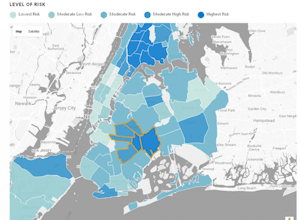

Investing in Central Brooklyn
Insights
March 13, 2017

Governor Cuomo has unveiled a plan to invest $1.4 billion in central Brooklyn that could be a game-changer for children and families in the area.
The plan, dubbed Vital Brooklyn, advances a holistic approach to fighting poverty that our research has shown is desperately needed. The Central Brooklyn communities of Brownsville, Bedford Stuyvesant, Crown Heights, and East New York all rank high-risk or moderate-high risk in our Community Risk Ranking across multiple domains – health, education, housing, youth services, economic stability, and family and community services.
In East New York, for example, outcomes for children are faring poorly across the board. More than a third of families are rent-burdened, and more than ten out of every 1,000 families in the community enter a homeless shelter. More than ten percent of infants born in the community are low birthweight babies, and less than a fifth of students are deemed proficient in math and English language arts. Nearly 11 percent of teens are neither working nor in school, half of all children live in single-parent households, and nearly a quarter (22.9%) of adults in the area do not have a high school degree.
Any one of these risk factors in isolation would pose challenges to children experiencing them, but when numerous risk factors are present they have a compounding quality negatively impacting both short and long term outcomes. So we were happy to see that Vital Brooklyn includes funding and plans for initiatives that address a wide spectrum of critical issues including healthcare, affordable housing, new jobs, recreational space, anti-violence programming, and job training. Together investments in these areas can help families find and keep well-paying jobs, access preventative healthcare and move into stable housing. That economic, medical and housing stability in turn can help children do better in school and get on track to college or a career, which reduces the likelihood they will end up idle, or having a child before they’re ready, or be homeless as adults.
Building off our Community Risk Ranking, CCC has undertaken qualitative work to better understand why certain barriers to wellbeing persist in central Brooklyn and specifically Brownsville. Over the past year and a half, we’ve worked with community members and stakeholders in Brownsville to garner feedback on data defining risks and needs in the community and to collect comprehensive data on community assets and identify opportunities to improve well-being for children and families there. In a community where nearly a third of the population is under 18 and the poverty rate is double the citywide rate, we found that a shortage of certain resources as well as multiple barriers to accessing existing resources contribute to many of the poor outcomes for Brownsville children.
For example, we found that the share of women who receive late or no prenatal care in Brownsville-Ocean Hill is twice the borough-wide rate. When speaking with community members, we learned many had concerns about the quality of local medical facilities and thus only accessed urgent or emergency care instead of routine and preventative services. We also discovered that the amount of open recreational space in Brownsville is currently at one-fifth of the optimal ratio put forth by City Environmental Quality Review. That lack of space means there are few safe places for residents to exercise, engage with the outdoors, and come together as a community.
These findings and many more will be released in the coming weeks in a full report on the Brownsville community. While the report unearths opportunities for improvements to services and resources, it also highlights people who live and work in Brownsville and are eager to help the community thrive. We look forward to working with our community partners to ensure that Vital Brooklyn helps deliver the high-quality resources and opportunities the people of Brownsville and residents throughout Central Brooklyn deserve.


